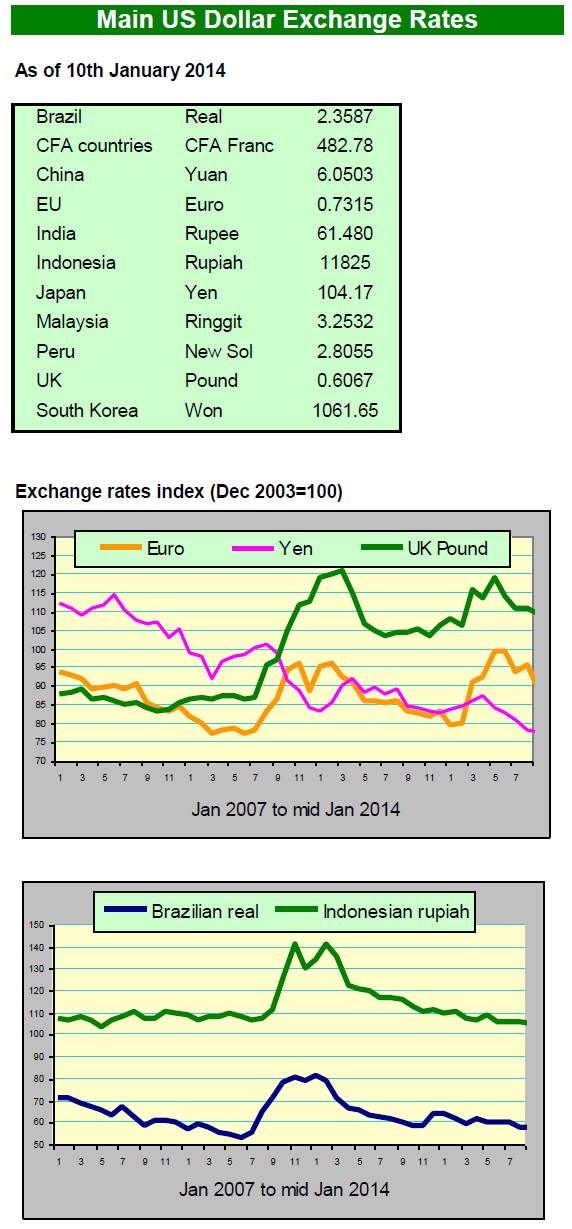2. GHANA
Progress on timber tracking
The EU/FLEGT Newsletter of Nov/Dec 2013 says Ghana
and the EU reviewed progress made by Ghana in
developing its legality assurance system, especially its
verification protocols and wood tracking system.
During a joint meeting it was agreed that effective tracking
is a considerable challenge within the VPA
implementation process. The two parties agreed to develop
a detailed work plan to guide implementation as Ghana
works towards licensing.
New policy to tackle depletion of forest resources
To halt the depletion of the country‟s forest and natural
resources the Ministry of Lands and Natural Resources has
introduced a Forest and Wildlife Policy. The new policy is
an improvement on the 1994 policy and addresses the
many challenges facing the forestry sector.
The policy will focus on the commitment to degraded
landscape restoration through forest plantation
development schemes, the promotion of small and
medium forest and wildlife enterprises to create
employment.
The policy also addresses biodiversity conservation,
sustainable management of Savannah wood land and
ecotourism development.
The policy aims to consolidate good governance through
accountability and transparency, enhance active
participation of communities and land owners in resource
management and address issues on tree tenure and benefit
sharing.
The Minister of Lands and Natural Resources, Alhaji
Inusah Fuseini, who launched the policy, noted that the
cost of degradation of the nation's forest and wildlife was
about 10% of gross domestic product.
The minister also announced that, a Forestry Development
Master Plan would be developed to ensure effective
implementation of the new Forest and Wildlife policy.
Inflation soars
Inflation rate in Ghana is now 17.5%, up by 2.5%
following last month‟s delivery of the 2014 budget
statement by the Minister of Finance Mr. Seth Terker.
A significant aspect of the budget was the change in scope
of the value added tax (VAT) to widen the tax net. The
new VAT structure received presidential assent on
December 30, 2013 and was subsequently gazetted the
following day.
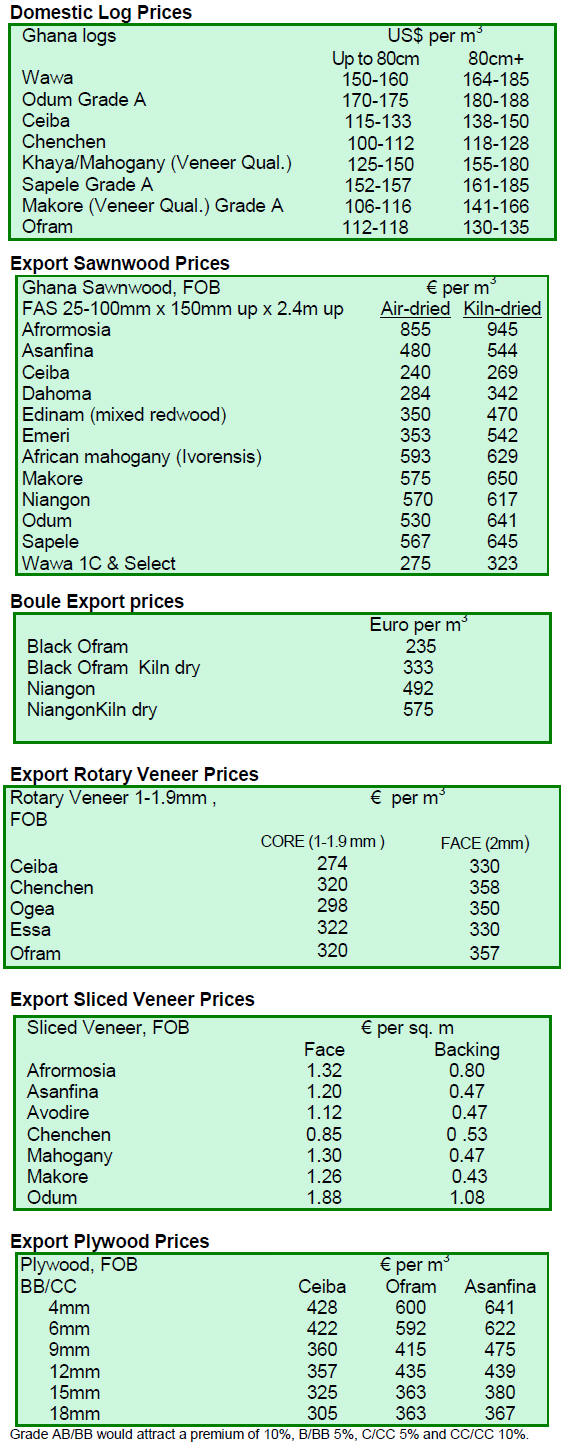
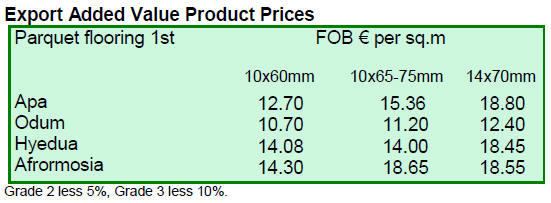
¡¡
3. MALAYSIA
Heated discussions in Sabah on royalty
rates
The year has started quietly for the timber industry.
Industry watchers anticipate that this quiet mood will last
till after the Chinese New Year which falls on 31 January.
Meanwhile, the most closely watched issue is in Sabah
where the industry is in discussions with the state
government on proposed changes to timber royalty rates.
Any increase in rates will have a big impact on the
industry.
Market prospects in Japan favourable says research
firm
Analysts from Affin Research, a firm affiliated with Affin
Investment Bank Ltd, are optimistic that 2014 will be a
good year for the timber industry. They foresee stronger
demand with moderate improvements in timber prices
underpinned by diminishing resources, recent stabilisation
of the Indian rupee, Myanmar‟s log export ban and
improved economic outlook in Japan, notably for
plywood.
Affin Research projected that log prices would average to
about US$250 to US$260 per cu.m in 2014 (up by around
US$20 to US$30per cu.m from an average of US$230 to
US$240 per cu.m in 2013).
Affin Research noted that the Japanese housing market
recovered in 2013 but whether this can be maintained after
the consumption tax is raised in April is uncertain. Any
improvement in housing starts is very positive for
Malaysian plywood exporters.
Reconstruction in the earthquake and tsunami devastated
areas in north-eastern Japan and construction of venues
for the Olympic Games in 2020 will surely boost demand
for more timber.
Positive outlook for demand from India
Log exports to India accounted for 61% of Sarawak‟s total
log exports in 2013. India‟s imports from Sarawak slowed
in mid-2013 due to the sharp depreciation of the Indian
rupee against the US dollar but prices picked up towards
the end of 2013 because of firm demand prior to the rain
season and because the rupee exchange rate stabilised.
Demand for logs in India could be strong this year if the
housing market picks up.
Malaysian log exporters are expected to benefit from the
log export ban in Myanmar. The reduced availability of
non-teak hardwoods should result in upwards pressure on
prices in all markets.
VPA negotiations continue
Malaysia continues to negotiate with the EU on the
Voluntary Partnership Agreement (VPA) and analysts
anticipate that representatives from Peninsular Malaysia
will be concluding their negotiations soon so as to sign a
VPA.
The state authorities in Sabah have stepped up activities to
speed negotiations with EU but in Sarawak the state
authorities have made it clear they would adopt a phased
approach towards the VPA.
Sarawak Timber Association explains its position VPA
Sarawak‟s position on the VPA negotiations has attracted
much international attention. The Sarawak Timber
Association (STA) recently released a statement on the
FLEGT VPA to explain its position.
The main elements of the STA statement are reproduced
below:
Malaysia has been negotiating with the EU over the EUMalaysia
FLEGT VPA. The State Government of Sarawak
has taken the cautious stance by adopting a phased
approach to the signing of the EU-Malaysia FLEGT VPA
which is on a voluntary basis.
Sarawak Timber Association (STA) fully supports this
decision made by the State Government as STA strongly
believes that the real benefits to the industry must first be
forthcoming.
STA would like to emphasize that even though Sarawak¡¯s
licensing authority will be unable to issue FLEGT
Licenses having taken the phased approach if Malaysia
signs VPA, but this does not mean that timber and timber
products from Sarawak are illegal.
Sarawak has already in place a legality verification
system to ensure its timber and timber products are legally
sourced and exported to a final destination which is in
compliance with the requirements of the existing forestry
laws and regulations. This has been accepted by our
international markets.
Since the VPA is a voluntary bilateral trade agreement,
there must be reciprocal benefits for the timber-producing
country.
STA sees the advantage of the VPA is to provide a green
lane for expeditious import into the EU BUT notes that
being included in the VPA does not confer any
commitment to a guaranteed market share which is very
important for the continuous survival of our timber
industry.
STA wishes to highlight that there is no common
agreement globally on what elements constitute the
definition of legal timber.
It is very subjective on how one interprets what legal
timber is and this has caused timber-producing countries
to incur higher transaction costs without any market
premium to meet the demand of the markets with its
different criteria and objectives due to the different
definitions of what is legal timber.
STA therefore supports any initiatives by timberproducing
countries to explore mechanisms and
arrangements, such as mutual recognition that can
eventually lead to the harmonization of the categories of
laws to be used to define what legal timber is for the
benefit of the timber industry internationally as a whole.
4. INDONESIA
Further debate on plantation log export
The suggestion that limited log exports could be resumed
has generated considerable debate. The idea was first
made by the Association of Indonesian Forest
Concessionaires (APHI) who said such a change in the ban
on log exports would generate better prices and offer
opportunities for market diversification.
It was suggested by the Ministry of Forestry that logs from
either community plantation forests (HTR) or industrial
forest plantation concessions could be exported provided
they come from areas covered by SVLK certificates.
Hadi Daryanto, the Forestry Ministry‟s secretary-general
said ¡°exports would be limited to companies fulfilling the
SVLK certification requirements so exports would not be
on a massive scale and so quota would be imposed and the
log trading would be mainly driven by market demand¡±.
Leading by example ¨C government agencies to use
only SVLK certified products
The government has said it would require government
institutions to use only timber and timber products that
have been certified through the timber legality verification
system (SVLK).
Forestry Minister Zulkifli Hasan said that his ministry,
along with the Government Procurement Regulatory Body
(LKPP), the National Development Planning Board
(Bappenas), the Public Works Ministry and the
Environment Ministry were drafting a regulation on the
use of wood products by government agencies.
Forestry Ministry director general for forestry business
development, Bambang Hendroyono, said the new
regulation would help to boost the domestic use of SVLKcertified
products. The number of companies that had
secured SVLK certification stood at 632 at the end of
December.
Imported wood should comply with RI certification
The Indonesian government intends to limit wood product
imports to products which comply with domestic
certification standards so that manufacturers using
imported raw materials will no longer need pre-export
inspection.
Bachrul Chairi, the Trade Ministry Director General
said
where the export country had a certification system
comparable to that in Indonesia the mutual recognition
agreements would be concluded.
Through such agreements Indonesia would be
acknowledging the legality system in its trading partners
and vice versa. Arrangements for this scheme are expected
to be in place this year according to Bachrul Chairi.
VPA implementation advances
The EU and Indonesia recently agreed a draft action plan
for the ongoing implementation of the VPA according to
the EU FLEGT Facility Newsletter of Nov/Dec 2013.
The action plan is based on findings from the first phase of
an independent evaluation of Indonesia‟s timber legality
assurance system conducted in 2013.
The action plan describes planned improvements to SVLK
regulations, amendments to VPA annexes, development of
new legislation and capacity building.
Preparations to ratify the Indonesian¨CEU VPA are
ongoing.
The International Trade Committee of the EU Parliament
is reviewing the treaty while the Indonesian President‟s
office is preparing for its ratification by the national
legislature.
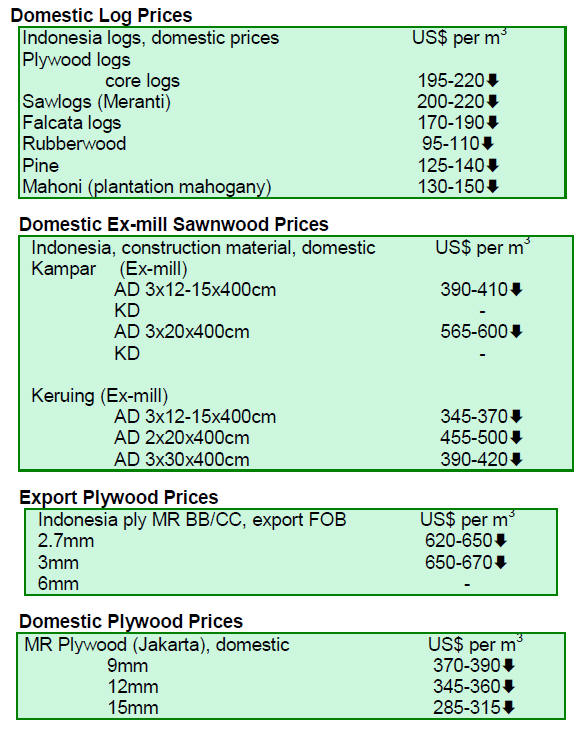
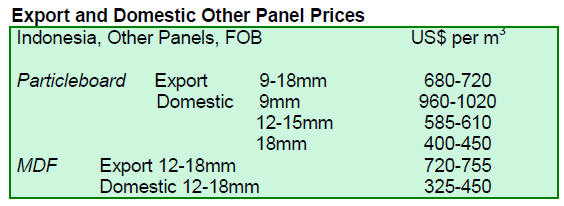
5. MYANMAR
Unlikely all accumulated teak and
hardwood logs can
be shipped before log export ban
Export shipment volume increased in December however,
it is estimated that around 270,000 cu.m of teak logs and
810,000 cu.m of other harwood logs remain unshipped at
various log depots in Myanmar.
Analysts say that it is unlikely that this quantity of logs
could be shipped in the three months until the log export
ban takes effect.
Shipments to date during the 2013-14 financial year are
shown below.
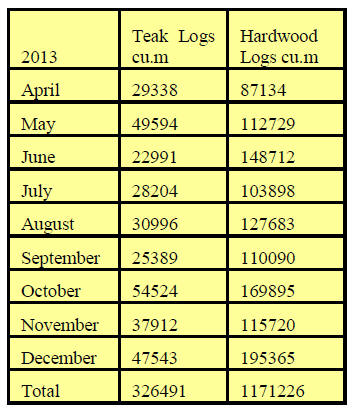
MTE informs on transactions after the log export ban
The log export ban (LEB) is set to begin immediately the
2014-15 financial year begins which will be midnight on
the 31 March 2014. It is understood that at this time all
loading of logs bound for export will be halted.
On 24 December the Myanma Timber Enterprise (MTE)
issued a statement on pre and post log export ban
procedures and a summary is provided below:
Before the log export ban
(1). Payment for log shipments must be made by 28
February 2014 and loading of vessels must be concluded
before 31 March 2014.
(2). Buyers having outstanding balances on purchase
contracts may conclude purchases at contracted FOB
prices provided the logs are processed inside the country.
In this case payments are to be made (in full) before 30
June 2014. From 1 July 2014, all remaining
unshipped/unpaid logs under existing contracts will
become the property of the MTE and sold by open tender.
After the log export ban
After 31 March 2014 grading and sales of logs will be
undertaken as follows:
(1) Industrial raw logs will be sold by open tender to
sawmills and factories operating under Myanmar
Investment Commission approval and to mills and
factories from the private sector.
(2) Teak log Grades 6 and Grade 7 will be grouped
together and re-designated as Grade 6. Logs that do not
fall in the category of Grade 6 will be sold as Grade 7.
(3) Grades for Padauk logs (Pterocarpus macrocarpus) will
remain as currently used, except that the Export Reject
Grade (ER) will be called Domestic Quality.
(4) For other hardwood logs what is currently termed
Export Quality will become First Quality and Export
Reject Grade will become Second Quality.
(5) Logs that are to be sold by open tender will be parceled
in Yangon and in other suitable locations outside Yangon.
(6) Auction deposits will be US$3000 for companies
owned by Myanmar nationals; and US$5000 for
companies owned by foreigners.
(7) If (full) payment for the successful lots are not paid
within (60) days, the respective lots will revert to MTE for
resale by open tender.
For more information contact MTE:
http://www.myanmatimber.com.mm/index.php/contact-us
December teak log tender results
The following grades and volumes were sold by Myanma
Timber Enterprise (MTE) through competitive bidding on
13 and 16 December 2013.
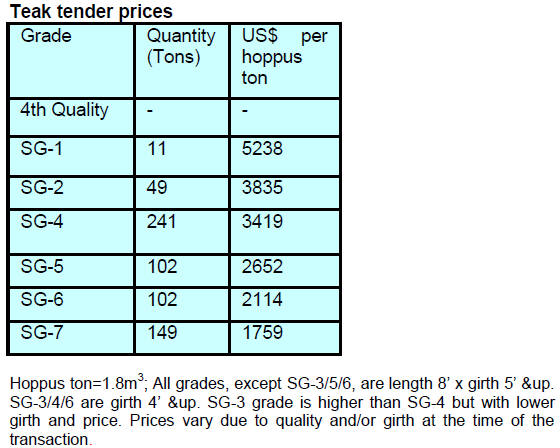
¡¡
6.
INDIA
Housing market growth forecast for early
2014
Developments in the economy and legislative changes
impact prospects for growth in the housing sector and this
directly affects demand for wood products.
Since the beginning 2003 India‟s GDP growth was around
8% per annum and inflation was a modest 5% but during
2013 there was a reversal as India‟s GDP growth stalled at
around 5% and inflation almost reached 10%. Against this
economic backdrop, growth in the housing market has
weakened.
During the last quarter of 2013 the Indian media talked of
an over-supply of housing and a slowing of demand for
urban housing. This led some struggling developers to
offer discounts and free extras not part of the normal deals.
Despite the current weakness in the housing market
analysts expect that in first few months of 2014 demand
will resume and prices will respond accordingly.
On the other hand, developers are raising concerns over
the possible impact of the recently introduced Land
Acquisition Act which came into effect on 1 January 2014.
The larger real estate companies are afraid that the act will
result in cost increases for infrastructure and residential
developments and could add between 15 per cent and 45
per cent to development costs.
However the Minister for Rural Development has said the
act will not affect private purchases of private land as it
applies only to land acquired by Central and State
authorities for any public purpose. The fear on the part of
developers is that the rehabilitation and resettlement
clauses of the act could drive up land prices as land
owners will see higher prices being paid by the state.
Paper industry concerned on import duty change
The domestic paper industry, which is struggling with a
chronic shortage of pulpwood is facing a new challenge in
the form of cheaper duty free imports from ASEAN
member countries.
Up until the 1 January 2013 the import duty on paper was
2.5% but this has now been eliminated and became zero
with effect from the beginning of this year under the terms
of the trade agreement between ASEAN countries.
The domestic supply of pulpwood is limited and prices
have increased by as much as 70-80 per cent over the past
two years to about Rs.10,000 per tonne but even at this
price there is no adequate supply and domestic mills have
to import the shortfall.
The paper industries raised paper prices by 10-15 per cent
during 2013 which brought domestic paper price to
Rs.52,000 per tonne. The landed cost of similar paper
from South Korea is around Rs.48,000 so imports have
been growing.
With the change in duties as a result of the ASEAN
deal
imports of coated paper, copier paper and specialized
products are expected to increase. Currently India imports
around 8~900,000 tonnes of these types of products
annually with China being the major supplier.
With the change in duties producers, such as Indonesia,
will have an opportunity to expand exports to India.
Auction prices of domestic teak at Western India
Forest Depots
During the last auctions of 2013 at various log depots in
the Dangs division approximately 12,000 cubic metres of
logs were sold. The majority of these were freshly felled
good quality logs.
Average prices recorded at the most recent auction are as
follows:
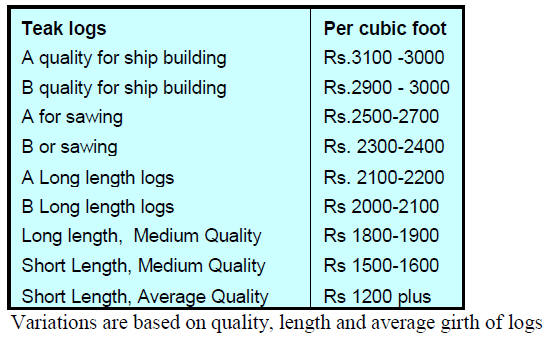
¡¡
The lack of demand from building companies
depressed
overall prices but the available logs were sold as sawmills
needed to restock the logs used up during the monsoon
period when auctions do not take place.
Good quality non-teak hardwood logs of Haldu (Adina
cordifolia), Laurel (Terminalia tomentosa), kalam
(Mitragyna parviflora) and Pterocarpus marsupium, 3 to 4
m in length having girths 91cms and up were sold at prices
in the range of Rs.600~850 per cu.ft while medium quality
logs were priced at 400 ~550 per cu.ft.
Now that the holiday season is over demand is expected to
rise and substantial quantities of logs are expected to be
put up for sales in coming months.
Availability of alternatives creates competition for teak
exporters
The stabilised rupee exchange rate has provided some
relief for importers. As it is the dry season in many
plantation teak supply countries the volumes offered have
increased.
Some suppliers of plantation teak are asking for higher
prices but, with the present economic situation and the
weak housing market in India, is not surprising that
importers do to accept price increases, on the contrary,
Indian buyers are pressing for reduced prices.
Also, the availability of other tropical hardwoods
at
competitive prices is creating tougher competition for teak
suppliers and holding down prices.
Current C & F prices for imported plantation teak, Indian
ports per cubic metre are shown below.
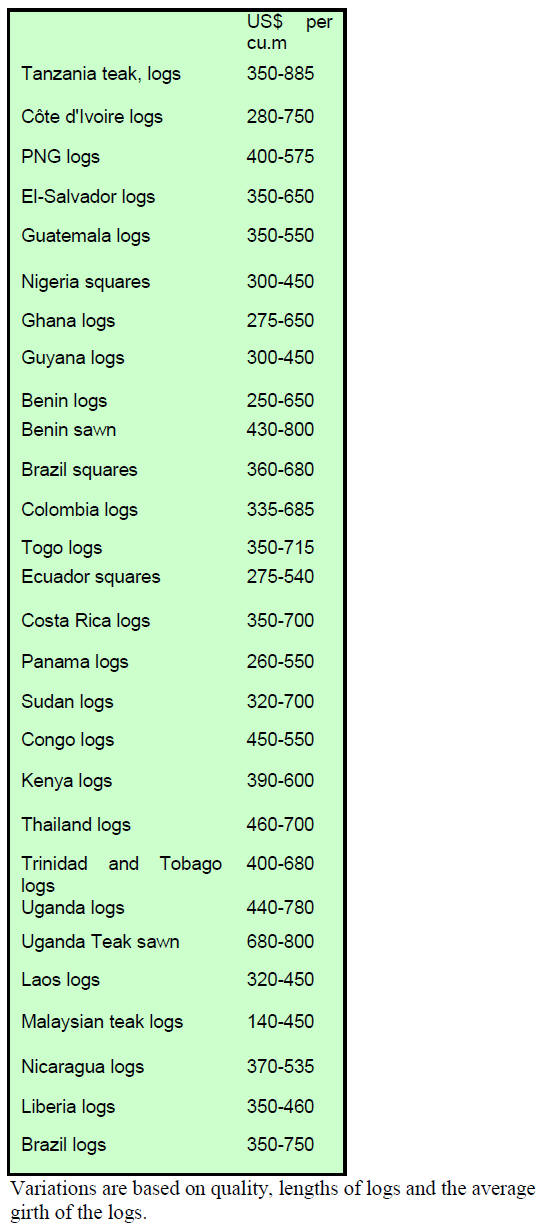
Recently plantation teak was imported from Cameroon
at
prices in the range of US$350 to 510 per cu.m
Domestic ex-sawmill prices for air dried
sawnwood cut
from imported logs
As demand and supplies remain balanced and the rupee
exchange rate is stable landed costs for imported logs have
not changed so sawnwood prices remain unchanged.
Prices for air dry sawnwood per cubic Foot, ex-sawmill
are shown below.
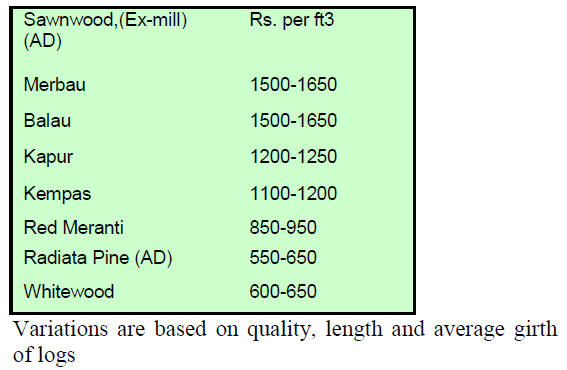
Domestic prices for Myanmar teak processed in
India
Export demand for teak products manufactured in India
continues to be good but domestic demand for Myanmar
teak products is only from selective high net worth clients.
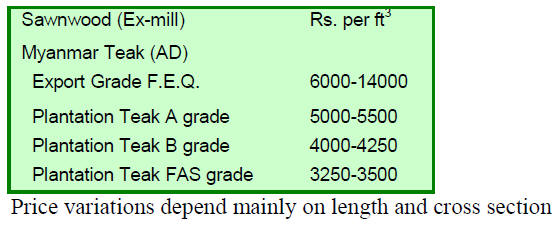
Prices for imported sawnwood
Ex-warehouse prices for imported kiln dry (12% mc.)
sawnwood per cu.ft are shown below.
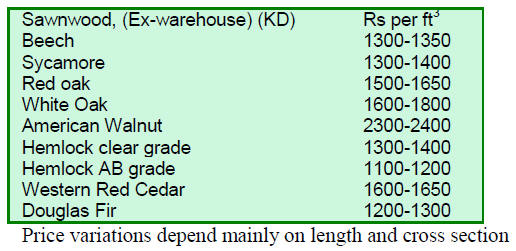
Plywood Market
The housing sector continues to be very depressed and
plywood manufacturers are suffering from rising
production costs and want to increase prices immediately
but the current demand is not supportive of this.
Plywood prices on the domestic market remain
unchanged.
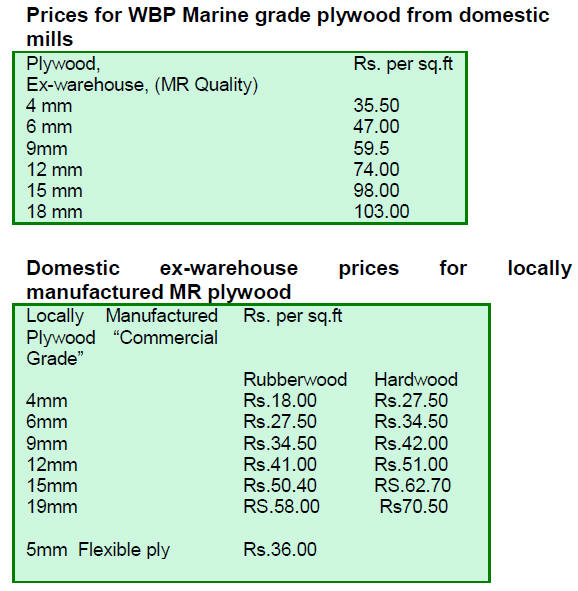
7.
BRAZIL
Rio 2016 driving demand for
certified wood
An agreement between FSC Brazil and the Olympic
organising committee for Rio 2016 provides for all wood
products used for event venues to be certified.
Certified, in this case is defined as complying with the
FSC principles and criteria that go beyond the compliance
with existing law and is said to include workers rights,
indigenous people issues and local community‟s rights.
This initiative has precedent in the 2012 London Games in
which more than two-thirds of the wood products in the
Olympic Park and over 90% of the wood products used in
the Olympic Village were FSC certified.
The aim of the Brazilian Olympic Committee is to
demonstrate leadership with new standards of
sustainability management.
Improvements in the timber sector in Mato Grosso
State
Mato Grosso is one of the major tropical timber producing
states in northern Brazil. Over the past few years the
forestry sector in the State has encountered difficulties in
raising industry awareness on issues of sustainable
development so as to demonstrate to international markets
that the industry is acting responsibly, is vibrant and in its
economic activities is respecting the environment.
To create greater sector transparency the Center for
Timber Producers and Exporters Industries of Mato
Grosso (Cipem), with support from the Fund for Wood
Sector Support (Fundo de Apoio ¨¤ Madeira - Famad),
launched a publication that features timber industry
developments between 2009 and 2013.
The report is entitled ¡°On the right track in
defense of
forest-based industry (No caminho certo em defesa da
Base Florestal)¡± and describes how forestry is promoted in
the state.
The report also presents details on issues such as the
participation of forest industries in international events,
sustainability issues, timber industry worker skills and
qualifications, management, fiscal and tax policies that
affect the sector as well as data on timber production,
exports, tax levels and employment.
One of the highlights of the publication is reference to the
„Program for Sustainable Forestry Development of Mato
Grosso‟ (PDFS/MT) due to be released in February 2014.
This programme will further support achieving a
sustainable forest-based industry in the state.
Mato Grosso timber sector performance in 2013
The forest industries of Mato Grosso State exported
97,900 tons of wood products, from January to November
2013, earning some US$93.7 million.
According to the Ministry of Agriculture, Livestock and
Supply (MAPA) and the Bureau of Foreign Trade,
Ministry of Development, Industry and Foreign Trade
(Secex / MDIC), export volumes in 2013 (Jan-Nov) were
up 4.1% year on year and export earnings were up 1.5%.
Sawnwood accounted for the bulk of 2013 exports at
51,960 tons. Exports of sawnwood earned US$42.2
million, 5.9% more than in the same period in 2012.
The second ranked export product was solid wood profiles
at 23,722 tons (Jan - Nov 2013) up 4.5% compared to the
22,694 tons recorded in 2012. 2013 revenue from exports
of solid wood profiles totaled US$42.4 million, compared
to US$ 42.8 million of the previous year.
In the first half of 2013 export revenues declined despite
an almost 7% increase in export volumes however, during
the second half of the year prices recovered.
Furniture exports slipped in 2013
The indications are that Brazil‟s furniture exports in 2013
will be some 15% down on levels in 2012. Despite the
weaker than expected 2013 export performance the
furniture sector expanded output by over 6%.
It is expected that 2014 wooden furniture exports will be
higher than in 2013 which will support further expansion
of domestic production.
According to a study by the Institute for Industrial and
Market Studies (IEMI), while exports slipped in 2013,
furniture imports increased by over 6% to 13.5 million
pieces.
The IEMI study shows that exports accounted for 3% of
furniture production in 2013. An expansion of furniture
imports has been observed since 2010 and in all
subsequent years.
Furniture manufacturers are concerned that the withdrawal
of the tax relief provided through a reduction in the IPI tax
(tax on industrialized products) will undermine
competitiveness especially as they also face rising interest
rates.
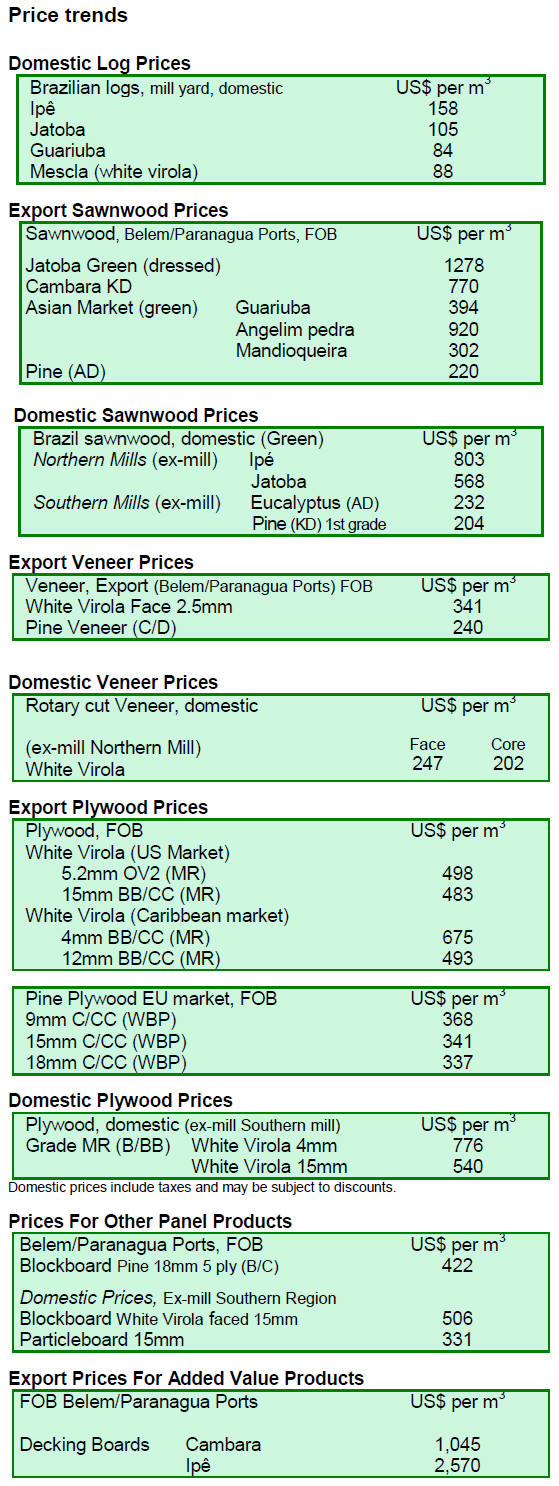
¡¡
8. PERU
Ambitious forest concession plan launched
The Agriculture Minister Milton Von Hesse, said his
ministry has an ambitious forest concession plan for this
year and is aiming to attract large scale investments and
entrepreneurship to support sustainable forest
management.
In support of this the Director General of Forestry and
Wildlife explained that the agency was working with
regional governments to determine production forest
stocks.
In this regard the minister said that by the middle of this
year inventories will be concluded in Ucayali and San
Martin. The forest inventory in the Loreto region has been
completed and work is now underway to delimit
concession areas. By late 2014 the first series of forest
concessions will be offered and it is hoped these will
attract international companies.
Financing for production forestry
Agrobanco will continue its financial support for
responsible forestry enterprises. The business manager of
Agrobanco, Hector Liendo, said that Agrobanco is the
only Peruvian financial entity offering credit to promote
the production forest sector.
Agrobanco supports investment in commercial logging,
reforestation with native species, conservation of forests
and wildlife and as such helps create employment
opportunities in the sector.
Liendo also said Agrobanco is in a position to provide the
same level of finance as in 2013 and can support
requirements for working capital and fixed asset purchases
allowing entrepreneurs and small timber producers to
purchase machinery enabling them to work efficiently
within the requirements of the Forestry and Wildlife Act.
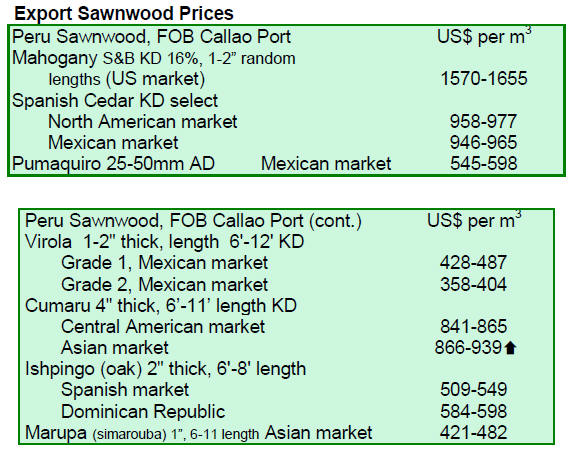
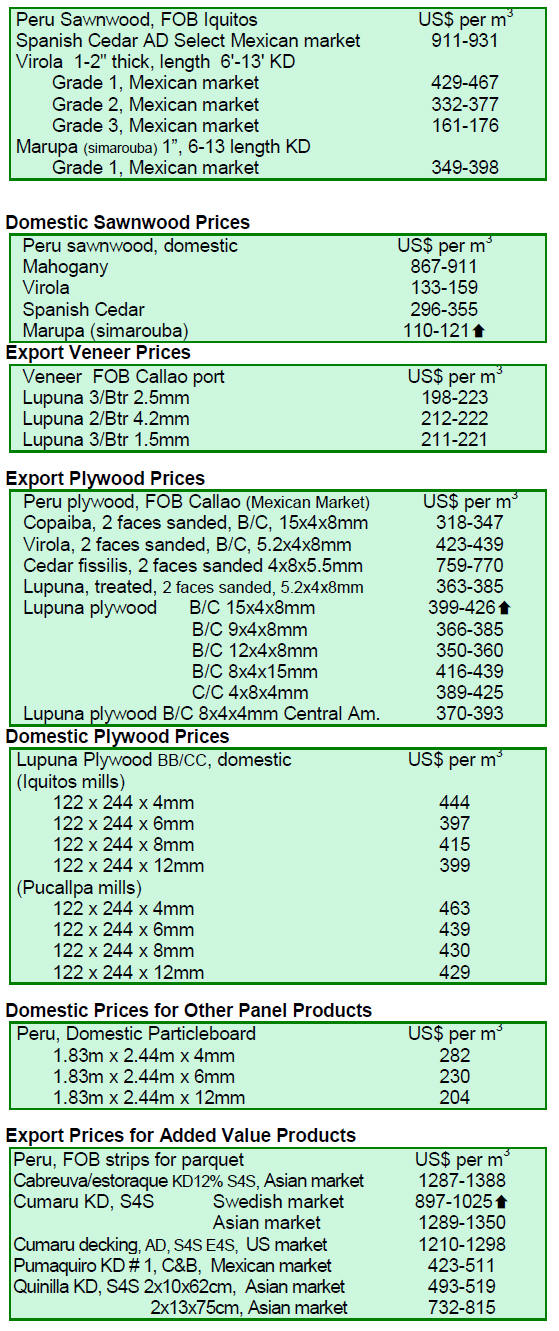
¡¡
9.
GUYANA
Log market quiet over holiday period
Over the holiday period the market was understandably
slow. There was no export of greenheart and mora logs
and it was only for purpleheart that there was some trade
with Standard sawmill quality logs securing a fairly good
FOB price of US$235 per cubic metre. The primary
market for the export of purpleheart logs was Asia.
But, shipments of sawnwood continue unabated
Despite the holiday season, sawnwood maintained a
healthy presence in the export market. Undressed
greenheart managed to secure favourable prices on the
export market.
For Undressed Select quality greenheart the top end FOB
prices fell from US$1,145 to US$954 per cubic metre,
while for Undressed Sound category greenheart sawnwood
the market price was only fair at US$848 per cubic metre.
For Undressed Merchantable quality greenheart, top end
price were more positive, increasing from US$721 to
US$997 per cubic metre, FOB. The major market for
Undressed greenheart was the Caribbean, Europe and
North America.
FOB prices for Undressed purpleheart changed with Select
category earning as much as US$1,100 per cubic metre.
The main market for this Undressed purpleheart was New
Zealand.
Undressed mora prices held firm in contrast to the
previous period and for Select category sawnwood price
were around US$976 per cubic metre FOB. For
Merchantable qualities the FOB price was US$500 per
cubic metre with Europe and North America being the
main market.
Dressed sawn greenheart export prices were favourable
and top end prices were as high as US$1,885 per cubic
metre FOB in markets ranging from the Middle East and
the Caribbean.
Dressed purpleheart sawnwood prices remained relatively
stable during this period compared to the previous period
and top end FOB prices slipped from US$1,187 to
US$1,103 per cubic metre with the Caribbean being the
major market.
Plywood prices unchanged
Prices for Baromalli (Castostemma commune) plywood
remained steady at US$584 per cubic metre FOB, a level
that has been unchanged for months. Guyana plywood
attracts buyers in Central America and the Caribbean.
Roundwood products such as piling, poles and posts made
a positive contribution to export earning. Greenheart piling
top end prices reached US$712 per cubic metre FOB in
the US market.
Wallaba transmission poles were in demand in the
Caribbean earning as much as US$834 per cubic metre
FOB, while wallaba posts secured a fairly good price of
US$649 per cubic metre also in Caribbean markets.
Wallaba shingles (Splitwood) exports were fair securing
prices in the region of US$977 per cubic metre FOB.
Guyana‟s added value products were in demand over the
holiday season .Guyana‟s beautiful crafted and exotic
timber species were utilised to create items which found
their way to the Caribbean markets.
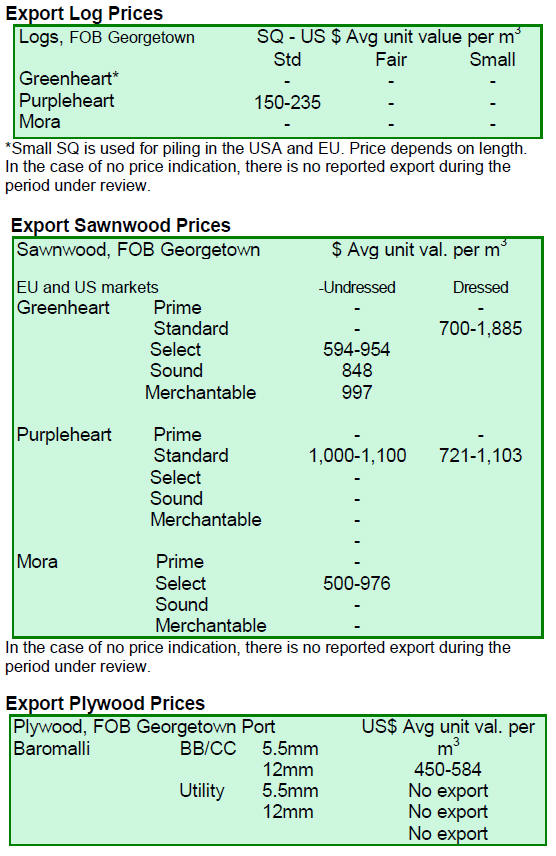
¡¡
